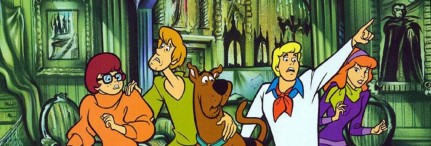In his kind and generous review of my first mystery, DEATH NOTICE, author James Reasoner said the plot was vaguely reminiscent of something found in Scooby-Doo, only played seriously. He meant it as a compliment and I took it as such. In fact, I was thrilled by the comparison, because Scooby-Doo was my favorite cartoon growing up and continues to influence me today.
What? I hear you collectively say. You’re influenced by a cartoon about a bunch of brightly dressed pesky kids? That’s ridiculous!
But it’s not. Influences come in many forms, and if it works, it works. In fact, every mystery writer could benefit from having the Scooby Gang in mind when they sit down to write. Now, I’m not saying that you should insert a talking German shepherd into your book. (Although more power to you if you do.) But I do think Scooby-Doo offers lessons that all mystery writers should take to heart. Here are just a few:
FORM A MOTLEY CREW
In all honesty, the Scooby Gang shouldn’t have been friends. Fred was handsome but bland. Daphne was, well, Daphne. Velma was the smart one. Shaggy was the cut-up. And Scooby was the inadvertent hero who often saved the day while really trying to sprint away in fear. Yet it worked. Each of them brought something to table, whether it was Fred’s steadfastness or Daphne’s ability to alert everyone to when she got goosepimples. And it was invariably interesting to see them paired up in different combinations.
So when creating a set of characters, mix them up a little. Form a crew of people who are different, who will sometimes clash, who will bounce against each other. Every character has something to offer and the best stories allow them to prove their worth, no matter their skills are.
LOGIC IS IMPORTANT — UP TO A POINT
The Scooby Gang ended up in some pretty strange places. Like that haunted riverboat in the bayou, for example. Or that creepy castle in the middle of nowhere. Or that spooky abandoned mansion that Mama Cass inherited. But when I was watching it as a child, I didn’t question why they were there or dwell on the strange twists of fate led the Harlem Globetrotters to that desolate hotel when their tour bus broke down. I didn’t care. They were there and I was happy to watch them.
It’s the same with readers. By necessity, most mysteries walk a fine line between plausibility and outright ridiculousness. But readers know this. They’re prepared to willingly suspend disbelief if an author can entertain them for a few hundred pages. So don’t worry if your plot is vaguely preposterous. Most mystery plots are. If you do your best to ground it in reality, then readers will happily turn the pages.
GIVE YOUR CHARACTERS AN APPETITE
I refuse to get into the reasons Scooby and Shaggy always had the munchies. That’s not for me to speculate about. All I know is that those two were hungry. I’m talking let’s-forget-about-that-zombie-roaming-this-abandoned-mansion-and-dig-up-some-grub-in-the-kitchen hungry. (I’m also not going to theorize on why the kitchens in these creepy, abandoned mansions always seemed to be fully stocked with sandwich fixings.) What matters is that they had an appetite, and they were more interesting characters because of it.
So when creating your characters, be sure to give them appetites as well. It doesn’t have to be food, although that’s a nice start. Kat Campbell, the heroine of DEATH NOTICE and BAD MOON, has an amusingly desperate thirst for coffee. That appetite can be for music. Or extreme sports. Or sex. Or drugs. What the characters hunger for outside of the main plot makes them more human and interesting, and — just like Shaggy ignoring the investigation at hand in search of a sandwich — can shape their actions and attitudes.
BLIND THEM LIKE VELMA
The Scooby Gang wasn’t perfect, nor did I want them to be. They all had flaws that made their quest to unmask the bad guy that much harder to attain. Even Velma, the smartest one in the room, had to fumble around on the floor like an idiot every time she lost her glasses.
And that, really, is what characters need to do. After reading an early draft of DEATH NOTICE, my agent told me that the investigation in the book went too smoothly. “They need to bump into walls and encounter dead ends,” she told me. In short, she wanted them to fumble around like Velma, on their hands and knees in the dark, reaching out for any bit of information they could find. I did, and the book was better for it.
DO NOT LET YOUR CHARACTERS SAY “JINKIES”
Trust me, it will only make them look silly.






